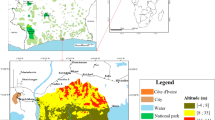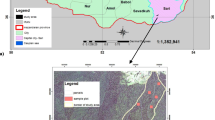Abstract
The survey and continuing inventory in the Bavarian Forest National Park of deadwood areas resulting from a spruce bark beetle calamity are being performed by means of visual evaluation of colour infrared aerial photographs. With the aid of the object-oriented image analysis software eCognition, it was possible to develop a partially automated method for this purpose. In order to verify the classification results, a test area was classified, and the results compared with those obtained by the previously used method. In addition, the classification results from two consecutive years were compared, and accuracy assessment methods were used to scrutinize the results. Classification in the deadwood areas yielded a total classification accuracy of 91.5%. In regard to objectivity and degree of detail, the newly developed method is significantly superior to the former method, which is based on visual interpretation with a stereo workstation. One problem, however, was the insufficient spatial accuracy of the respective orthophotos. Because of this, it was not possible to detect changes over the course of specified time intervals. Therefore, a practical application of this method would require that the orthophotos from various dates or times be precisely spatially assigned. This requirement can be achieved with the production of new orthophotos.



Similar content being viewed by others
References
Andresen T, Mott C, Zimmermann S, Schneider T, Melzer A (2004) Erfassung und Beurteilung von aquatischen und terrestrischen Feuchtgebieten mit sehr hoch auflösenden FE-Daten. Bayer. Akad. f. Naturschutz u. Landespflege, Laufener Seminarbeitr 2/03:47–53
Baatz M, Schäpe A (2000) Multiresolution segmentation—an optimization approach for high quality multi-scale image segmentation. In: Angewandte Geographische Informationsverarbeitung. Beiträge zum AGIT-symposium Salzburg 2000. Herbert Wichmann Verlag
Baatz M, Benz U, Dehghani S, Heynen M, Hltje A, Hofmann P, Lingenfelder I, Mimler M, Sohlbach M, Weber M, Willhauck G (2002) eCognition user guide. Definiens Imaging, München
Benz U, Hofmann P, Willhaug G, Lingenfelder I, Heyen M (2004) Multiresolution, object-oriented fuzzy analysis of remote sensing data for GIS-ready information. ISPRS J Photogramm Remote Sens 58:239–258
Blaschke T, Hay G (2001) Object oriented image analysis and scale-space theory and methods for modelling and evaluation multiscale landscape structures. Int Archives Photogramm Remote Sens 34(Part 4/W5):22–29
Blaschke T, Strobl J (2001) What’s wrong with pixels? Some recent developments interfacing remote sensing and GIS. GIS-Zeitschrift für Geoinformationssysteme 6/2001(S.):12–17
Brunett C, Blaschke T (2003) A multi-scale segmentation/object relationship modelling methodology for landscape analysis. Ecol Model 168(2003):233–249
Chalifoux S, Cavayas F, Frey J (1998) Map-guided approach for the automatic detection on Landsat TM images of forest stands damaged by Spruce Budworm. Photogram Eng Remote Sens 64(6):629–635
Congalton RG, Green K (1999) Assessing the accuracy of remotely sensed data: principles and practices. Lewis Publishers, Boca Raton
De Kok R, Schneider T, Ammer U (1999) Object based classification and applications in the alpine forest environment. Int Arch Photogramm Remote Sens vol 32, Part 7-4-3 Wg, Valladolid, Spain, 3–4. June, 1999
Flanders D, Hall-Beyer M, Pereverzoff J (2003) Preliminary evaluation of eCognition object-based software for cut block delineation and feature extraction. Can J Remote Sens 29(4):441–452
Foody GM (2002) Status of land cover classification accuracy assessment. Remote Sens Environ 80:185–201
Franklin SE (ed) (2001) Remote sensing for sustainable forest management. Lewis Publishers, New York, pp 296–300
Franklin SE, Raske S (1994) Satellite remote sensing of Spruce Buworm defoliaton in western Newfoundland. Can J Remote Sens 20(1):37–48
Gillis M, Leckie D (1993) Forest inventory mapping procedures across Canada. Forestry Canada, PNFI information report PI-X-114. 79 pp
HÁJEK F (2005) Object-oriented classification of remote sensing data for the identification of tree species composition. In: Proceedings of ForestSat 2005 conference, May 31–June 3, 2005, Boras, Sweden
Heese S, Schmullius C (2005) Approaches to Kyoto afforestation, reforestation and deforestation mapping in Siberia using object oriented change detection methods. In: Erasmi S, Cyffka B, Kappas M (eds) Remote sensing and GIS for environmental studies. Göttinger Geographische Abhandlungen, vol 115. Göttingen 2005
Hellden U (1980) A test of landsat-2 imagery and digital data for thematic mapping illustrated by an environmental study in northern Kenya, Lund Univ Nat Geog Inst, Lund, Sweden, Techn Rep 47
Heurich M (2006) Evaluierung und Entwicklung von Methoden zur automatisierten Erfassung von Waldstrukturen aus Daten flugzeuggetragener Fernerkundungssensoren. Forstliche Forschungsberichte München. 202/2006
Heurich M, Neufanger M (2005) Die Wälder des Nationalparks Bayerischer Wald. Ergebnisse der Waldinventur 2002/2003 im geschichtlichen und waldökologischen Kontext. Wissenschaftliche Schriftenreihe der Nationalparkverwaltung Bayerischer Wald. Band 16
Heurich M, Fahse L, Reinelt A (2001) Die Buchdruckermassenvermehrung im Nationalpark Bayerischer Wald. In: Waldentwicklung im Bergwald nach Windwurf und Borkenkäferbefall. Wissenschaftliche Schriftenreihe der Nationalparkverwaltung Bayerischer Wald. Band 16
Hildebrandt G (1996) Fernerkundung und Luftbildmessung für Forstwirtschaft, Vegetationskartierung und Landschaftsökologie. Wichmann Verlag. Heidelberg
Itten K, Meyer P, Kellenberger T, Leu R, Sandmeier ST, Bitter P, Seidel K (1992) Correction of the impact of topography and atmosphere on landsat TM forest mapping of Alpine regions; remote sensing series, vol 18, University of Zürich
Janoth J, Eisl M, Klaushofer F, Luckel W (2002) Sementasierte Verfahren zur Veränderungsanalyse und Waldklassifizierung mit hochauflösenden Satellitendaten. Fernerkundung und GIS: Neue Sensoren-innovative Methoden. Wichmann, Heidelberg, pp 98–107
King DJ (2000) Airborne remote sensing in forestry: sensors, analysis, applications. For Chron 76(6):859–876
Krzystek P (2003) Digitale Aerotriangulation im Nationalpark Bayerischer Wald. Unveröffentlicher Bericht. 4 S
Krzystek P, Bögel U (2004) Orthofotoerstellung “Nationalparkverwaltung Bayerischer Wald” 1994 und 2004. Unveröffentlichter Bericht. 12 S
Mitri GH, Gitas IZ (2006) Fire type mapping using object-based classification of Ikonos imagery. Int J Wildland Fire 2006(15):457–462
Mott C, Andresen T, Rogg C, Schneider T, Zimmermann S, Ammer U (2004) AQUATIC: Identifizierung und Monitoring von Landnutzungs-/Landoberflächen-Typen in einem multitemporalen/multisensoralen Ansatz. Bayer. Akad. f. Naturschutz u. Landespflege, Laufener Seminarbeitr 2/03:55–65
Rall H, Martin K (2002) Luftbildauswertung zur Waldentwicklung im Nationalpark Bayerischer Wald 2001—Ein neues Verfahren und seine Ergebnisse zur Totholzkartierung. In: Berichte aus dem Nationalpark, Nationalparkverwaltung Bayerischer Wald 1 (2002)
Schneider T, Kok R, De Buck A, Manakos I (2000) Objektorientierte Bildanalyse—Paradigmenwechsel in der thematischen Auswertung von Erdbeobachtungsdaten. In: Lehrstuhl für Landnutzungsplanung und Naturschutz (Hrsg.): Landnutzungsplanung und Naturschutz: Aktuelle Forschungsberichte. Festschrift zur Emeritierung von Prof. Dr. Ulrich Ammer (2000), 234–258
Schöpfer E, Lang S (2006) Object fate analysis—a visual overlay method for the categorization of object transition and object based accuracy assessment. In: Lang S, Blaschke T, Schöüfer E (eds) Proceedings of the 1st international conference on object based image analysis, 4–5 July 2006, Salzburg, Austria
Short NM (1982) The Landsat tutorial workbook—basics of satellite remote sensing, NASA ref. Pub. 1078, Greenbelt
Smits PC, Dellepiane SG, Schowengerdt RA (1999) Quality assessment of image classification algorithms for land-cover mapping: a review and a proposal for a cost-based approach. Int J Remote Sens 20(8):1461–1486
Tiede D, Hoffmann CK (2006) Process oriented object—based algorithms for single tree detection using laser scanning data. In: EARSeL proceedings, 3-D in remote sensing in forestry, 14–15.02.06, Vienna, Austria, 151–156
Tiede D, Blaschke T, Heurich M (2004) Object-based semi-automatic mapping of forest stands with laser scanner and multi-spectral data. Int Arch Photogramm Remote Sens Sp Inf Sci XXXVI(Part 8/W2):328–333
Wulder MA (1998) Optical remote sensing techniques for the assessment of forest inventory and biophysical parameters. Prog Phys Geogr 22(4):449–476
Wulder MA, Skakun RS, Dymond CC, Kurz WA, White JC (2005) Characterization of the diminishing accuracy in detecting forest insect damage over time. Can J Remote Sens 31(6):421–431
Zöhrer F (1980) Forstinventur. Ein Leitfaden für Studium und Praxis. Pareys Studientexte 26. Verlag Paul Parey. Hamburg und Berlin. 207 pp
Author information
Authors and Affiliations
Corresponding author
Additional information
Communicated by D. Mandallaz.
Rights and permissions
About this article
Cite this article
Heurich, M., Ochs, T., Andresen, T. et al. Object-orientated image analysis for the semi-automatic detection of dead trees following a spruce bark beetle (Ips typographus) outbreak. Eur J Forest Res 129, 313–324 (2010). https://doi.org/10.1007/s10342-009-0331-1
Received:
Revised:
Accepted:
Published:
Issue Date:
DOI: https://doi.org/10.1007/s10342-009-0331-1




